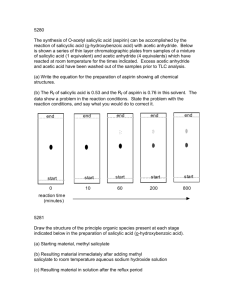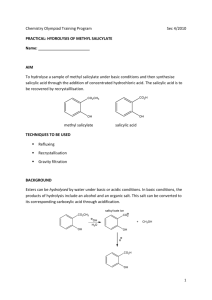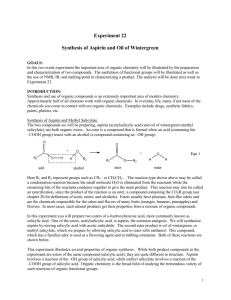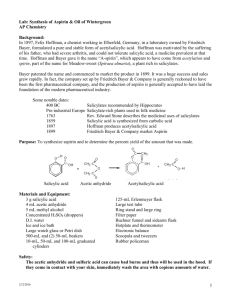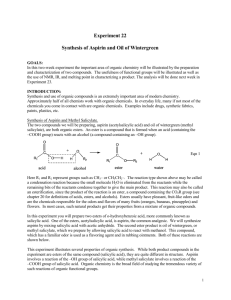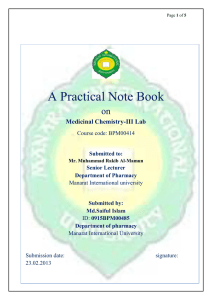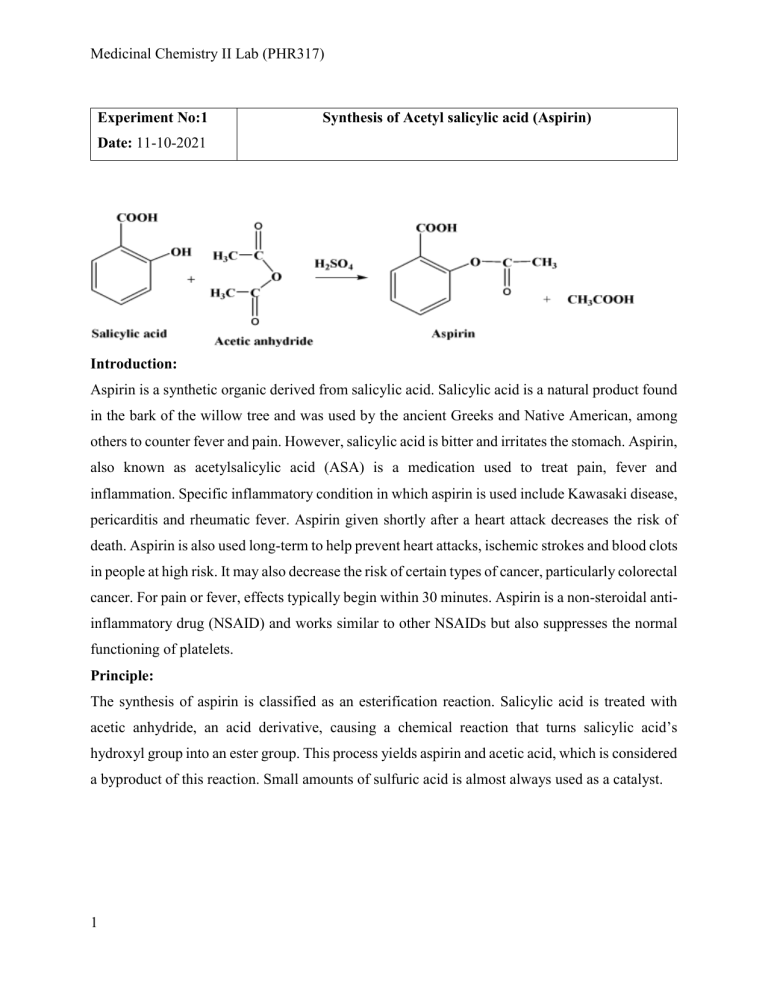
Medicinal Chemistry II Lab (PHR317) Experiment No:1 Synthesis of Acetyl salicylic acid (Aspirin) Date: 11-10-2021 Introduction: Aspirin is a synthetic organic derived from salicylic acid. Salicylic acid is a natural product found in the bark of the willow tree and was used by the ancient Greeks and Native American, among others to counter fever and pain. However, salicylic acid is bitter and irritates the stomach. Aspirin, also known as acetylsalicylic acid (ASA) is a medication used to treat pain, fever and inflammation. Specific inflammatory condition in which aspirin is used include Kawasaki disease, pericarditis and rheumatic fever. Aspirin given shortly after a heart attack decreases the risk of death. Aspirin is also used long-term to help prevent heart attacks, ischemic strokes and blood clots in people at high risk. It may also decrease the risk of certain types of cancer, particularly colorectal cancer. For pain or fever, effects typically begin within 30 minutes. Aspirin is a non-steroidal antiinflammatory drug (NSAID) and works similar to other NSAIDs but also suppresses the normal functioning of platelets. Principle: The synthesis of aspirin is classified as an esterification reaction. Salicylic acid is treated with acetic anhydride, an acid derivative, causing a chemical reaction that turns salicylic acid’s hydroxyl group into an ester group. This process yields aspirin and acetic acid, which is considered a byproduct of this reaction. Small amounts of sulfuric acid is almost always used as a catalyst. 1 Medicinal Chemistry II Lab (PHR317) PROCEDURE: 1. 1.25 gm of dry salicylic acid and 1.75 ml of acetic anhydride was placed in a small conical flask, 2 drops of concentrated sulphuric acid was added, and then rotated the flask in order to secure thorough mixing. 2. Then mixture was warmed in a water bath about 50-60°C, stirring with the glass rod for about 15 minutes, then the mixture was kept to cool and stirred occasionally. 3. Added 25 ml of distilled water, stirred well and filtered at the vacuum pump. 4. Then, recrystallized the crude acetylsalicylic acid with a mixture of 7.5 ml alcohol and 20 ml of hot water. When solid separates at this point, warmed the mixture until solution was completed and then allowed the clear solution to cool in a freeze dry oven. PROPERTIES OF THE FINAL PRODUCT: Properties: 1. Its molar mass is 180.16 g/mol with density of 1.40 g 2. Its melting point is 136 ℃ and boiling point is 140℃. 3. It's soluble in water is that 3g of aspirin can dissolve in 1 liter of water. 4. It is a white crystalline solid at room temperature and weakly acidic in nature and acid dissociation constant is 3.5 at 25ºC. With vinegar odor at high concentrations 5. Empirical Formula is C9H8O4 and Molecular formula is CH3COOC6H4COOH and IUPAC name is 2acetoxybenzoic acid 6. It gets hydrolyzed on coming in contact with moist air. Although it is stable in dry air. 7. It easily decomposes in the solution of ammonium acetate, carbonates, citrates or alkali metal hydroxides. 8. It can be explosive when mixed with air in its powdered form. 9. It is anti-inflammatory, anticoagulatory, anti-pyretic and analgesic effect. Solubility: In water Soluble (3 g.L-1) Incompatibility: It suppresses the normal functioning of platelets. It is not recommended during pregnancy and to children with infections, it incompatible with coagulation, asthma, GI toxicity, renal dysfunction, Reye's syndrome, anemia, dialysis, G-6-PD deficiency, hepatotoxicity and interacts with alcohol. Uses: 1. It is an analgesic and used to get relief from acute pain. 2. It is highly effective against muscle pain, bloating, skin irritation, gastric distension. 2 Medicinal Chemistry II Lab (PHR317) 3. It is also used for the treatment of migraine and is effective against cluster headache. 4. It is used in fever and it is anti-inflammatory so it is used to treat inflammation. 5. It is useful in the treatment of those parts of the heart which had an attack. 6. Aspirin is advised to take after surgeries like PCIs etc. 7. It reduces the risk of getting cancer Dose: 300 to 600 mg at every 4-6 hours Dosage form: Oral tablet Toxicity and adverse effect: It must not be taken in very high amounts because in very high concentrations acetylsalicylic acid may cause hallucinations and even death. It causes nausea, vomiting, bloating, muscle cramps, gastrointestinal irritation, gastritis, diarrhea, gastric ulcer, decrease in blood pressure, drowsiness, headache, heartburn etc. EQUIPMENT REQUIRED REAGENT REQUIRED Beaker Glass Rod Conical Flask Hot plate Fume Hood Drying oven Pure salicylic acid Acetic anhydride Concentrated Sulfuric acid Distilled water Rotatory evaporator A SHORT DESCRIPTION OF SYNTHESIS: Aspirin is synthesized by the action of salicylic acid on acetic anhydride. It is an esterification reaction. In this reaction, when salicylic acid reacts with acetic anhydride, the hydroxyl group of salicylic acid converts into an ester group. This results into aspirin and acetic acid. Sulfuric acid or phosphoric acid act as catalysts. Reaction is given below 3 Medicinal Chemistry II Lab (PHR317) DESCRIPTION OF FINISHED PRODUCT: ● Crystal shape: White crystalline solid ● Color: White ● Weight: 180.16 g/mol ● Yield value: 50.18% Calculation: RESULT: The yield value was found to be 50.18%. DISCUSSION: Aspirin ideal percentage yield should be between 90% to 100 %, but from the experiment conducted only 50.18% was found which is not ideal. This was due to experimental errors as the reaction may not be fully completed between salicylic acid and acetic anhydride and there might be product loss during filtering and recrystallization, product might be left behind in the apparatus or due to the fans turned on there might be product loss by air movements. All these errors committed causes the percentage yield to be extremely low than expected. PRECAUTIONs: 1. The equipment were handled carefully 2. The weight of the ingredients were taken properly 3. The reaction was allowed to complete before proceeding to next step. ANSWER THE FOLLOWING QUESTIONS: 1. Therapeutic indication: 4 Medicinal Chemistry II Lab (PHR317) a. Pain b. Fever c. Headache d. Inflammation e. Heart attack and brain stroke 2. Reaction mechanism: 3. Mechanism of action of the drug: Acetylsalicylic acid (ASA) blocks prostaglandin synthesis. It is non-selective for COX-1 and COX-2 enzymes. Inhibition of COX-1 results in the inhibition of platelet aggregation for about 7-10 days (average platelet lifespan). The acetyl group of acetylsalicylic acid binds with a serine residue of the cyclooxygenase-1 (COX-1) enzyme, leading to irreversible inhibition. This prevents the production of pain-causing prostaglandins. This process also stops the conversion of arachidonic acid to thromboxane A2 (TXA2), which is a potent inducer of platelet aggregation. Platelet aggregation can result in clots and harmful venous and arterial thromboembolism, leading to conditions such as pulmonary embolism and stroke. There is 60% homology between the protein structures of COX-1 and COX-2. ASA binds to serine 516 residue on the active site of COX-2 in the same fashion as its binding to the serine 530 residue located on the active site of COX-1. The active site of COX-2 is, however, slightly larger than the active site of COX-1, so that arachidonic acid (which later becomes prostaglandins) manages to bypass the aspirin molecule inactivating COX-2. ASA exerts more action on the COX-1 receptor rather than on the COX-2 receptor. A higher dose of acetylsalicylic acid is required for COX-2 inhibition. 5 Medicinal Chemistry II Lab (PHR317) Experiment No:2 Date: 11-10-2021 Synthesis of Methyl Salicylate from Aspirin Introduction: Esters are a class of organic compounds. An ester comprises an organic or inorganic acid in which one or more hydroxy(OH) groups have been replaced by an alkoxy (O-alkyl) group. For example, the simplest ester, methyl formate (CHO-OCH3), is made up of formic acid (CHO-OH) in which the hydroxyl group has been replaced by a methoxy group (-OCH3). Similarly, ethyl acetate (CH3CO-OCH2CH3) is made up of acetic acid (CH3CO-OH) in which the hydroxy group has been replaced by an ethoxy group (-OCH2CH3). Although esters can be produced by many mechanisms, the most commonly used method is called esterification, which is a condensation reaction between an alcohol and an acid, typically in the presence of a strong acid catalyst, such as sulfuric acid. For example, ethyl acetate can be produced by reacting ethanol (ethyl alcohol) with acetic acid and isopropyl butyrate by reacting isopropanol (isopropyl alcohol) with butyric acid. Esters typically have strong, often pleasant, scents and tastes, so many esters are used as flavorings and perfume agents, either individually or in combination. For example, the scent and taste of strawberries is due to the presence of (among others) methyl cinnamate, ethyl butyrate, ethyl caproate, isobutyl acetate, and benzyl acetate. Principle: In this lab, we’ll synthesize methyl salicylate, whose common name is oil of wintergreen. We'll synthesize methyl salicylate by reacting methanol with aspirin. Aspirin is actually a substituted salicylic acid, called acetylsalicylic acid, which is itself both an acid and an ester. 6 Medicinal Chemistry II Lab (PHR317) PROCEDURE: Part I: Synthesize Methyl Salicylate Performed this part of the lab in a well-ventilated area. The reaction produced a strong odor of methyl salicylate and methanol vapor. Made certain there were no open flames or other ignition sources nearby. 1. Transfered about 60 mL of methanol to the 125 mL Erlenmeyer flask. Added 13.00 g of aspirin to the flask and swirled until the tablets dissolve. (Aspirin tablets may contain binders that do not dissolve in methanol, which is no cause for concern.) 2. Added about 10.0 mL of concentrated sulfuric acid to the reaction vessel and swirled to mix the solutions. Was careful when added the acid slowly to avoid boiling the solution and causing some of the acidic solution to sputter out of the flask. 3. Clamped the flask to a ring stand and partially immersed it in a hot water bath at about 60°C. 4. Allowed the reaction to proceed, stirring the reaction mixture occasionally, for 60 minutes. As the methyl salicylate was formed , a distinct wintergreen odor was observed. Kept the reaction mixture at about 60°C, adding water to the bath when needed, to keep its level up. The level of the liquid in the reaction vessel have decreased as methanol evaporates from the flask. Added more methanol as needed to keep the reaction vessel near its original volume. 5. After 60 minutes, stopped adding methanol to the flask. Increased the heat slightly to bring the liquid in the reaction flask to a gentle boil. Boiled the solution long enough to vaporize most of the remaining methanol. 6. When enough methanol has boiled off to reduce the volume in the reaction vessel to about half its original volume, the flask was removed from the water bath and kept aside to cool. Part II: Isolate and Purify the Product The brown liquid in the reaction vessel is a complex solution that contains methanol, crude methyl salicylate, sulfuric acid, unreacted aspirin, and other impurities. Methyl salicylate is freely soluble in methanol, but only very slightly soluble in water. We’ll take advantage of that differential solubility to extract most of the water-soluble impurities from the crude product. 1. Poured the contents of the reaction flask into the sep funnel. 2. Added about 50 mL of ice cold tap water to the sep funnel, cap the funnel, and agitate the contents vigorously for 30 seconds. 7 Medicinal Chemistry II Lab (PHR317) Lab Technique Note: Generally, sep funnels need to be vented after vigorous shaking. Even if a gas isn’t generated, it’s good practice. The sodium bicarbonate wash in step 5 will definitely have to be vented during and after shaking. Enough gas is generated to blow the stopper off the back of the sep funnel. 3. Allowed the contents of the sep funnel to separate into two layers. The aqueous layer contains nearly all of the sulfuric acid and most of any other water-soluble impurities. (Make sure you know which layer is which.) Separated the two layers, and transfer the aqueous layer to the 250 mL beaker. 4. Have done a second washing by repeating steps 3 and 4. 5. Added about 50 mL of sodium bicarbonate solution to the sep funnel, cap the funnel, and agitated the contents vigorously for 30 seconds. (See previous note on venting) 6. Allowed the contents of the sep funnel to separate into two layers. The aqueous layer contains an excess of sodium bicarbonate and a small amount of sodium sulfate produced by the neutralization of any sulfuric acid that remained in the organic layer. Separated the two layers, and transferred the aqueous layer to the 250 mL beaker. 7. Neutralized the sulfuric acid in the 250 mL beaker with sodium carbonate (soda ash) and flushed the neutralized solution down the drain with plenty of water. Retained the organic layer in the sep funnel, which contained the crude methyl salicylate. PROPERTIES OF THE FINALPRODUCT: Properties: 1. Minty cool odor and reddish to yellow or colorless liquid appearance with characteristic odor of wintergreen. 2. Slightly soluble in water. Methyl salicylate is also soluble in the majority of the organic solvents. 3. The compound undergoes the process of hydrolysis if there is an aqueous base present. The hydrolysis of methyl salicylate results in the formation of methanol and salicylic acid. 4. Vapor pressure is 0.0343mmHg at 25ºC, boiling point 220-224 °C and melting point is -8.0 °C. Density is 1.17 g/cm³, pKa = 9.8 5. Molecular weight 152.15 g/mol. 6. IUPAC name is Methyl 2-hydroxybenzoate, empirical and molecular formula is C8H8O3 8 Medicinal Chemistry II Lab (PHR317) Solubility: 0.639 g/L (21 °C) 0.697 g/L (30 °C), slightly soluble in water and soluble in organic solvents Incompatibility: Oxidizing Uses: Very low concentration is used as a flavoring agent in candy, chewing gum, cough drops and toothpaste. Used in aromatherapy as oil of wintergreen. Used in cosmetics as a warming agent and in sport massage products as a rubefacient. Used as an anti-inflammatory incorporated into liniments and ointments for joint and muscle pains Dose: Rubbed over affected area up to 3-4 times a day Dosage form: Cream and ointment Toxicity and adverse effect: Methyl salicylate like other salicylates interferes with vitamin-k metabolism thereby decreasing blood clotting ability. For allergic individuals the risk of an adverse reaction is not dose related even a very small amount topically applied salicylate can generate an allergic response Mild itching, irritation, and redness at the spot of the application might appear. Swelling or blistering at the site of application or unusual or increased pain along with vomiting and nausea or ringing in the ears are conditions that require immediate medical attention. You must stop using this product if you experience these problems. Serious allergic reactions to methyl salicylate are rare, but if any symptoms are noticed like swelling, itching, trouble breathing, or severe dizziness, they must be reported to a doctor instantly. EQUIPMENT REQUIRED: REAGENT REQUIRED: balance hot water bath (60°C) test tube beaker, 50 mL beaker, 250 mL beaker, 600 mL separatory funnel Erlenmeyer flask, 125 mL 9 aspirin (13.0 g) methanol (~100 mL) sulfuric acid, concentrated (~10mL) saturated sodium bicarbonate solution (50 mL; 3.9 g/50 mL) Medicinal Chemistry II Lab (PHR317) graduated cylinder, 10 mL graduated cylinder, 100 mL pipette, 10.00 mL ring stand utility clamp (for flask) stirring rod eye dropper or Beral pipette thermometer A SHORT DESCRIPTION OF SYNTHESIS: Methyl salicylate is produced by esterification of salicylate acid using methanol. DESCRIPTION OF FINISHED PRODUCT: ● Crystal shape: Yellowish liquid/semi-liquid ● Color: Yellowish ● Weight: 152 g/mol ● Yield value: 75.14% Calculation: 10 Medicinal Chemistry II Lab (PHR317) RESULT: The percentage yield was found to be 75.14%. DISCUSSION: From the synthesis of methyl salicylate the obtained result shows that the yield is 75.14%. The yield is low so it’s an poor purity of methyl salicylate and yield of 90%-100% is a good yield results. The reasons behind can be the presence of foreign particles in the reagent or the contents might not be agitated vigorously or there was content loss while in vacuum pump, etc. Therefore, to obtain the optimal yield the above mentioned problems should be solved. PRECAUSTIONS: 1. The solution was not overheated 2. The equipment were handled carefully 3. The organic layer was carefully separated. ANSWER THE FOLLOWING QUESTIONS: 1. Therapeutic indication: Body aches, muscle and joint pains and arthritis. 2. Reaction mechanism: 11 Medicinal Chemistry II Lab (PHR317) 3. Mechanism of action of the drug: Methyl Salicylate acts a counter rubefacient. It acts by stimulating the superficial afferent nerves from the same spinal segment that supplies the underlying painful muscles. The stimulation of these nerves causes vasodilation in that spinal segment and that reduces the cause of pain in the deeper muscles. The counterirritants are called menthol and methyl salicylate. They work by making the skin feel cool and dry, afterwards. Such skin sensations prevent you from experiencing deeper the aches / pains in your muscles, joints and tendons. 12 Medicinal Chemistry II Lab (PHR317) Experiment No:3 Date: 11-10-2021 Synthesis of P- Aminobenzoic acid (PABA) Introduction: Para-aminobenzoic acid (PABA) is a chemical found in the folic acid vitamin and also in several foods including grains, eggs, milk, and meat. PABA is taken orally for sin conditions such as vitiligo, Dermatomyositis, morphea, Peyronie’s disease, scleroderma, pemphigus and lymphoblastoma cutis. It consists of a benzene ring substituted with amino acid and carboxyl groups. It is slightly soluble in water Principal: Pera-amino benzoic acid can be synthesized in the laboratory from p-nitro benzoic acid by reduction in presence of tin and hydrochloric acid. REACTION: + Sn + HCl → P-nitrobenzoic acid EQUIPMENT: 1. Balance 2. Round bottom flask 3. Reflux condenser 4. Water Bath 5. Beaker 6. Pipette 7. Litmus paper 8. Filter Paper 9. Suction pump 13 P-aminobenzoic acid Medicinal Chemistry II Lab (PHR317) REAGENTS/CHEMICAL: Sl. No. Name of the reagent Molecular weight Amount 1. P-nitro benzoic acid 167 5.0 g 2. Tin 3. Conc. hydrochloric acid 4. 12 g 36.5 25 mL Water 18 q.s. 5. Concentrated Ammonia solution 60 q.s. 6. Glacial Acetic Acid 17 q.s. PROCEDURE: 1. Five (5) g of p-nitro benzoic acid was placed in 1 liter round bottom flask fitted with a reflux condenser. 2. Twelve (12) g of granular tin and 25 mL of concentrated hydrochloric acid was introduced. 3. The mixture was heated gently until the reaction commenced and the flask was removed. 4. The flask was shaken frequently and it was taken care that the insoluble acid adhering to the sides of the flask is transferred to the reaction mixture. Occasional gentle warming may be necessary. After about 20 minutes most of the tin will have reacted and a clear solution remains. 5. It was allowed to cool somewhat and the liquid was decanted into a 250 mL beaker, the residual tin was washed by decantation with 15 mL of water and the washing to the contents of the beaker was added. 6. Concentrated ammonia solution was added until the solution is just alkaline to the litmus; the precipitate was filtered off and it was washed well with water. If the total volume of the combined filtrate and washing exceed 200 mL it was evaporated in a large evaporating dish on a water bath until the volume had been reduced to 175-200 mL and the solid was filtered off. 7. The liquid was acidified to litmus with glacial acetic acid and it was evaporated on a water bath until the crystal commenced to separate. 8. It was cooled in the ice, the crystals were filtered at the pump and dried in the steam oven. 9. Identify PABA using UV spectrophotometer. Properties of the Final Product (PABA) 14 Medicinal Chemistry II Lab (PHR317) Physicochemical properties: Physical state: White-grey crystalline powder and odorless Molar Mass: 137.14 g/ml Chemical formula: C7H7NO2 IUPAC name 4-aminobenzoic acid Solubility: Slightly soluble in water. The solubility of PABA is 6.1 g/l at 30oC in water, 125 g/l alcohol and 17 g/l ether. PABA is soluble in ethyl acetate and glacial acetic acid, slightly soluble in benzene, and practically insoluble in petroleum ether. Insoluble in chloroform, pet ether & benzene Density: 1.374 g/mol Vapor pressure: 4.5X10-6 mm Hg at 25 °C Acid dissociation: 2.38 (at 25 °C) and pH is pH (0.5% solution): 3.5 Melting Point: Theoretical Value: 187 ºC and Observed Value: 185 ºC Source: Chemical synthesis & naturally found in grains and meat. Uses: It is a part of folic acid molecule & is included as a component of Vitamin B-complex, multivitamin as well. To inhibit gastric acid secretion To treat male infertility To treat scleroderma (fibrous tissue growth in skin) PABA is used for eye infections caused by herpes virus Effective for sunburn Possibly effective for Peyronie’s disease PABA supplements can help them in the growth of new bacterial colonies in their intestine to maintain Gut flora. It can block ultraviolet radiations and be used as an essential component of different sunscreen lotions. It can be used as a supplement to treat depression, fatigue, weeping eczema, irritability, scleroderma, pigment loss from the skin in patches, and premature grey hair. 15 Medicinal Chemistry II Lab (PHR317) Incompatibility: Antibiotics (sulfonamide antibiotics) interacts with para-aminobenzoic acid and PABA can decrease the effectiveness of certain antibiotics called sulfonamides. Some of these antibiotics include sulfamethoxazole (Gantanol), sulfasalazine (Azulfidine), sulfisoxazole (Gantrisin), and trimethoprim/sulfamethoxazole (Bactrim, Septra) PABA might decrease the effectiveness of dapsone (Avlosulfon) for treating infections. The body breaks down cortisone to get rid of it. Paraaminobenzoic acid (PABA) might decrease how quickly the body breaks down cortisone. Taking PABA by mouth and getting a cortisone shot might increase the effects and side effects of cortisone. Dose: A typical therapeutic dose of PABA is 300-400 mg/day Dosage form: Tablet Toxicity and Adverse effect: PABA can cause skin irritation. It might cause nausea, vomiting, upset stomach, diarrhea, and loss of appetite. At higher dose, 12 g/day it causes severe liver toxicity. It has possibility to induce sunburn in some patients. PABA might build up in the kidneys making kidney disease worse. Do not use it if you have kidney problems. A SHORT DESCRIPTION OF SYNTHESIS: In industries, Para aminobenzoic acid is prepared by two routes. In one of the processes, terephthalic acid is used. Monoamide is produced from terephthalic acid. Hoffman degradation of this monoamide results in the formation of Para aminobenzoic acid. In another process, 4nitrobenzoic acid is reduced to form Para aminobenzoic acid. This reaction takes place in a controlled manner. Para aminobenzoic acid can also be obtained from different food sources like Brewer’s yeast, liver, unfiltered beer, molasses, mushrooms, whole grains, and animal kidneys. 16 Medicinal Chemistry II Lab (PHR317) CALCULATION: Result: Yield of para-aminobenzoic acid was 88.3 %. DISCUSSION: The percentage yield was found 88.3%, PABA is a multivitamin component that inhibits gastric acid secretion and use to treat male fertility. At the time of doing the experiment some products has lost due to experimental error and due to product sticking to the apparatus used, this has caused the final product mass to reduce thus reducing the percentage yield. PRECAUTION: 1. Hydrochloric acid is extremely caustic & conc. ammonia is severely irritating to the eyes and to the moist skin as well. 2. Safety glasses and gloves are mandatory. If any acid gets onto your skin, wash with excessive water. 3. All the weights should be determined precisely. 4. Filtration should be done carefully. 5. The drying process must be carried out properly. 6. The UV spectrophotometer should be handled carefully. ANSWER THE FOLLOWING QUESTIONS: 1. Therapeutic Indications: a. To inhibit gastric acid secretion 17 Medicinal Chemistry II Lab (PHR317) b. To treat male infertility c. To treat scleroderma (fibrous tissue growth in skin) d. PABA is used for eye infections caused by herpes virus e. Effective for sunburn f. Possibly effective for Peyronie’s disease 2. Reaction mechanism: 18 Medicinal Chemistry II Lab (PHR317) Experiment No:4 Synthesis of Acetaminophen Date: 11-10-2021 INTRODUCTION: Acetaminophen (paracetamol) is a synthetic non-opioid derivative of p-aminophenol. It is an effective analgesic and antipyretic drug. Activity of the drug on the hypothalamic heat-regulating center is the mechanism behind antipyretic effect, whereas analgesia is shown due to elevation of the pain-threshold. It is found to be effective in diseases accompanied by pain, discomfort and fever, for instance the common cold and other viral infections. It is also effective against arthritic and rheumatic disorders involving musculoskeletal pain as well as pain caused due to headache, myalgia, neuralgia etc. PRINCIPLE: Preparation of acetaminophen involves treating an amine with an acid anhydride to form an amide. In this case, p-aminophenol, the amine, is treated with acetic anhydride to form acetaminophen (pacetamidophenol), the amide. It is an acetylation reaction. PROCEDURE: 1. Placed 2g of the 4-aminophenol into a 50mL conical flask, add 7mL of water and stirred the suspension vigorously (magnetic stirrer) for a few minutes. 2. Added 2.2mL of acetic anhydride and continued stirring until the suspension dissolves. After that heated it in a water bath until completely evaporated. A precipitate (Paracetamol) was eventually forms. 3. After 10 minutes filtered the precipitate (using a Buchner funnel), then was washed with a small amount of cold, distilled water. 19 Medicinal Chemistry II Lab (PHR317) 4. After then was dryed, the crude product was placed in a clean 100mL conical flask and recrystallized by heating until it just dissolves in approximately 20mL of water. 5. Cooled the flask in ice until crystals of the purified paracetamol appeared. 6. Filtered the crystals under vacuum, dried in a warm oven and then recorded the melting point and compared with standard paracetamol tablets (~170◦C). 7. Repeated recrystallization process to achieve a more pure product. PROPERTIES OF THE FINAL PRODUCT: ● Properties: Colorless and odorless crystalline powder/ crystals. Bitter taste. pH (saturated aqueous solution) about 6. ● Boiling point: greater than 500ºC ● Melting point: 169-170.5 °C ● Molecular Formula: C8H9NO2 or HOC6H4NHCOCH3 ● IUPAC name: N-(4-hydroxyphenyl)acetamide ● Solubility: 12.78g/kg of water, very slightly soluble in cold water but greater solubility in hot water. Freely soluble in alcohol; soluble in methanol, ethanol, dimethylformamide, ethylene dichloride, acetone, ethyl acetate; slightly soluble in ether; practically insoluble in petroleum ether, pentane, benzene ● Density: 1.3 g/cm³ ● Vapor pressure: 6.29X10-5 mm Hg at 25 °C ● pH : Saturated aqueous solution 5.5-6.5, pKa = 9.38 ● Incompatibility: Interacts with alcohol. For patients with chronic alcohol ingestion or other liver enzyme inducers, especially barbiturates or anticonvulsants, when taking long-term or a large-scale use of this product, they may have a higher risk of liver toxicity. When combined with chloramphenicol, this product can prolong the latter t1/2 and enhance its toxicity. When combined with anticoagulant drugs, this product can increase the anti-bloodclotting effect. So it is necessary to adjust the dosage of anticoagulant drugs. When combining long-term large quantities of 4-Acetamidophenol with aspirin or other nonsteroidal anti-inflammatory drugs, it will increase the risk of renal toxicity.When combined 20 Medicinal Chemistry II Lab (PHR317) with the antiviral drug, zidovudine, it can increase the toxicity. We ought to avoid using at the same time. ● Uses: Treat fever, pain, headache, musculoskeletal pain, Dental and Other Post-Surgical Pain, Patent Ductus Arteriosus ● Dose: 500mg up to 4 times/day ● Dosage form: Tablet, suspension, syrup, suppository ● Toxicity and adverse effect: Nausea, over dose may cause renal and liver impairment. EQUIPMENT REQUIRED: REAGENT REQUIRED: Conical flask Water bath Glass rod R aminophenol Drying oven Distilled Water Fume hood Acetic Anhydride Filter paper Buchner funnel A SHORT DESCRIPTION OF SYNTHESIS: Paracetamol is synthesized by reacting 4-aminophenol with acetic anhydride. The function of acetic anhydride is to provide an acyl group to attach to the nitrogen, thereby transforming the amine to an amide. This reaction forms an amide bond and ethanoic acid as by products. After complementation of the reaction paracetamol is isolated and purified. 21 Medicinal Chemistry II Lab (PHR317) DESCRIPTION OF FINISHED PRODUCT: ● Crystal shape: Colorless crystal/crystalline powder ● Color: colorless ● Weight: 151g/mol ● Yield value: 56.5% Calculation: RESULT: Yield value found was 56.5 %. DISCUSSION: The percentage yield was found to be only 56.5% for the final product. The yield is very low and ideal percentage yield is between 90%-100%. Such low yield value found because of experimental errors. There might be product loss during filtering and recrystallization, product might be left behind in the apparatus or due to the fans turned on there might be product loss by air movements. All these errors committed causes the percentage yield to be extremely low than expected. PRECAUTION: 1.All the laboratory rules were tried to maintain carefully. 2.All the reagents and apparatuses were handled carefully. 3.Hot plate was handled carefully. 4.Measurements and calculations were done accordingly. 22 Medicinal Chemistry II Lab (PHR317) 5.Filtration was done carefully. ANSWER THE FOLLOWING QUESTIONS: 1. Therapeutic Indications: Treat fever, pain, headache 2. Reaction Mechanism: 3. Mechanism of action: It may reduce the production of prostaglandins in the brain. Prostaglandins are chemicals that cause inflammation and swelling. Acetaminophen relieves pain by elevating the pain threshold, that is, by requiring a greater amount of pain to develop before a person feels it. It reduces fever through its action on the heat-regulating center of the brain. Specifically, it tells the center to lower the body's temperature when the temperature is elevated. 23
